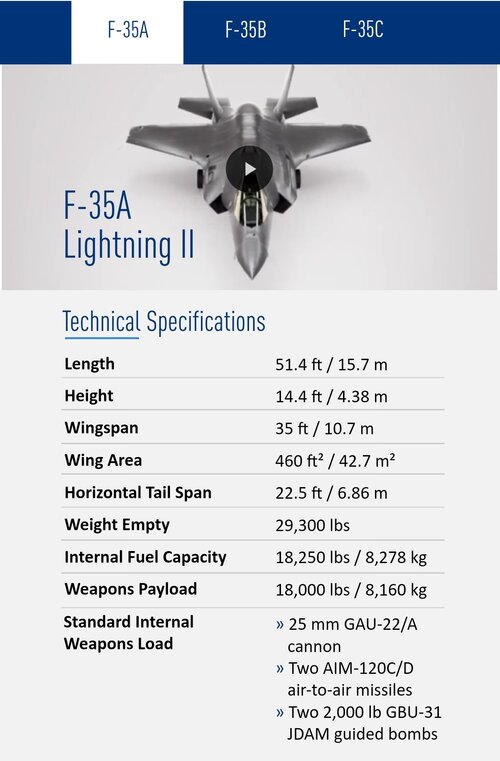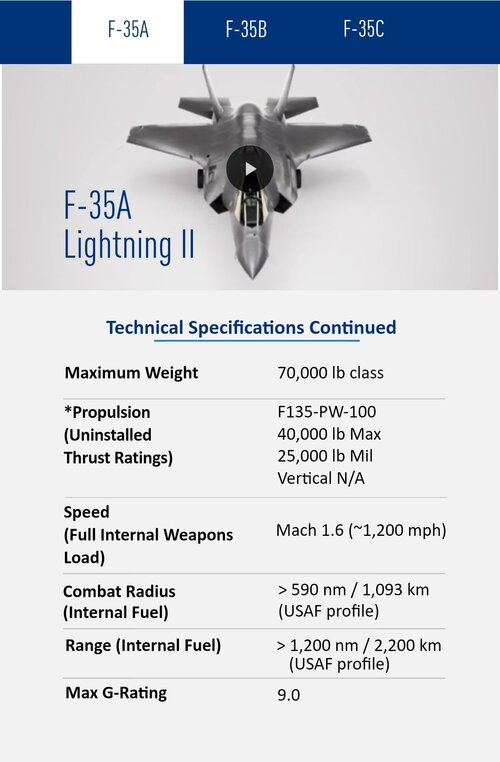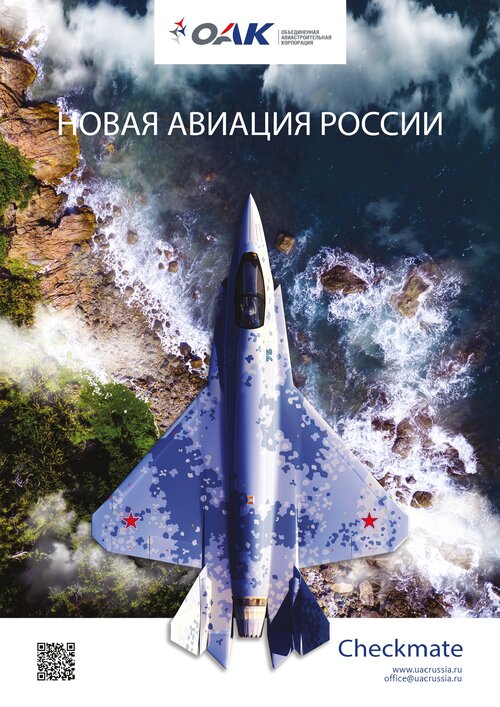By what source? I provided the links to USAF and RAAF websites, both of which give a very close figure around 2200 km.Now it is clear who is misleading the respected telegraph agencySpeaking about credibility. Remember, guys, i pointed at the mistake TASS made in their special report on LTS Checkmate? Where they confused F-35 combat radius with its range. I wrote them a letter and on the next day, when i visited their website to check if there is any reaction on the reader's feedback, that mistake has already been fixed.
Дальность самого массового варианта американской машины, F-35A, который и является основным конкурентом нашей машины на внешних рынках, составляет примерно 2200 километров(1200 морских миль 1200*1,853=2223,6км)
The flight range of the F-35A announced by the latter is 2752 km, naturally in miles
You are using an out of date browser. It may not display this or other websites correctly.
You should upgrade or use an alternative browser.
You should upgrade or use an alternative browser.
Sukhoi T-75 LTS (CheckMate)
- Thread starter sublight_
- Start date
LMFS
ACCESS: Top Secret
- Joined
- 19 March 2019
- Messages
- 534
- Reaction score
- 880
That comes from a combat radius value based on A2G load and less than optimal flight profile, the values for A2A with optimized flight profile (760 nm) come from an IAF presentation from 2016.By what source? I provided the links to USAF and RAAF websites, both of which give a very close figure around 2200 km.
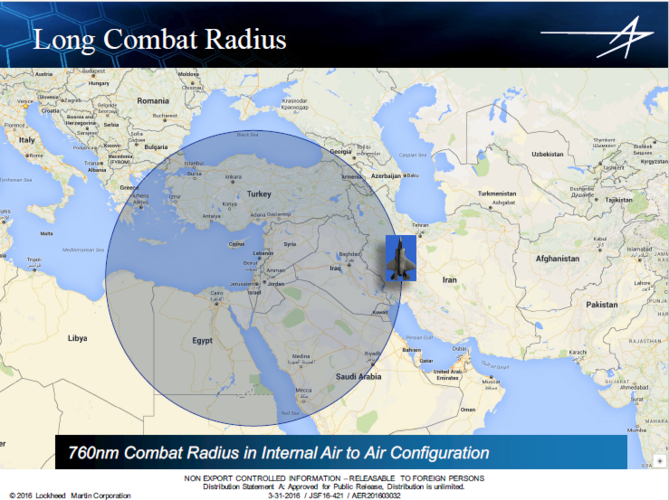
TBH, I tend to believe the historically consistent numbers, not this picture.That comes from a combat radius value based on A2G load and less than optimal flight profile, the values for A2A with optimized flight profile (760 nm) come from an IAF presentation from 2016.
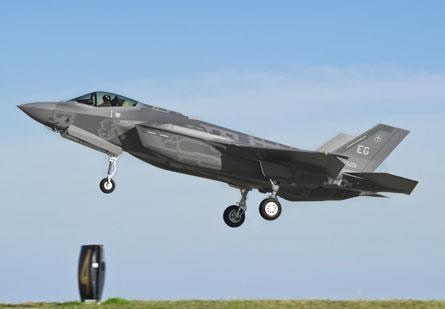
Pentagon agrees to F-35A combat radius reduction
The US military has slightly relaxed the Lockheed Martin F-35A's combat radius requirements ...
UPD: After all, this "combat radius" onthe picture could easily include the flight radius + the AMRAAM launch area, which gives a previously no-one-heard-of combat radius. Israelis are pretty ingenuious guys when they need to convince someone of what they need.
Last edited:
LMFS
ACCESS: Top Secret
- Joined
- 19 March 2019
- Messages
- 534
- Reaction score
- 880
You are talking about a 8 km range reduction decision from 2012...TBH, i tend believe to the historically consistent numbers, rather than this picture.
And...? Look my update in my previous post and the picture below. The figure of ~2200 km flight range is the common thing for all sources i saw since JSF requirements were released to the public for the first time. 2700+ km?! Excuse me my scepticism, but i don't buy it.You are talking about a 8 km range reduction decision from 2012...
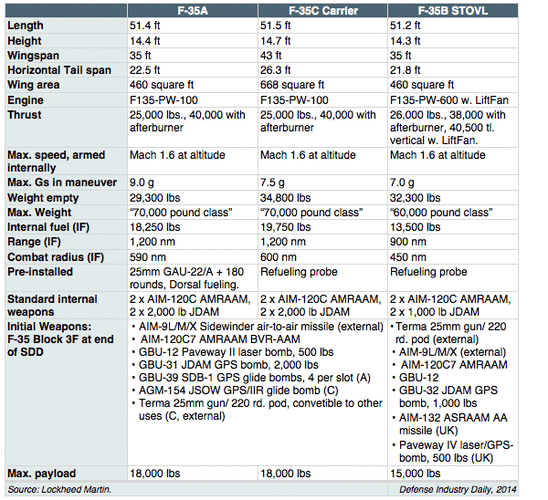
LMFS
ACCESS: Top Secret
- Joined
- 19 March 2019
- Messages
- 534
- Reaction score
- 880
There are other official documents stating 670 nm for CTOL variant, it all depends on the load and flight profile. The figure of >750 nm on A2A is easy to find, there are many instances where this has been mentioned. The combat radius the services demand vary on the flight profile they are considering their reference, it is not like in Russia where a max range on internal fuel is take as the logical reference, a practice which I would agree more than the US one BTW.And...? Look my update in my previous post and the picture below. The figure of ~2200 km flight range is the common thing for all sources i saw since JSF requirements were released to the public for the first time.
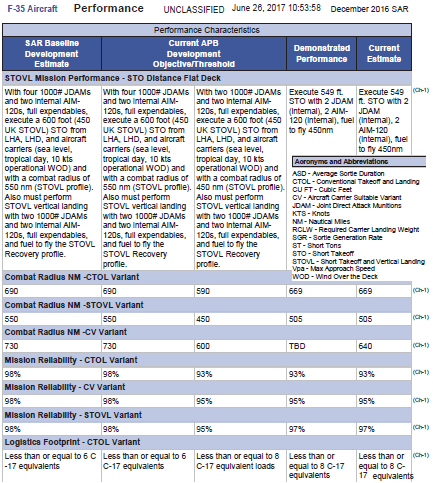
The plane carries more than 8 t fuel, probably even more than the LTS2700+ km?! Excuse me my scepticism, but i don't buy it.
Ok, you're probably right and this 590nm figure was the lowerest requiremen/threshold. But even this 669nm figure gives 91nm shorter combat radius than those 760nm stated by IAF.There are other official documents stating 670 nm for CTOL variant, it all depends on the load and flight profile. The figure of >750 nm on A2A is easy to find, there are many instances where this has been mentioned. The combat radius the services demand vary on the flight profile they are considering their reference, it is not like in Russia where a max range on internal fuel is take as the logical reference, a practice which I would agree more than the US one BTW.
As well as it carries a monstrous F135 engine... Again, you delivered to me really new and interesting info i wasn't aware about, and thank you for this, seriously...but i still don't know what to believe...The plane carries more than 8 t fuel, probably even more than the LTS
Acatomic
ACCESS: Secret
- Joined
- 18 October 2020
- Messages
- 245
- Reaction score
- 581
Maybe I can explain the confusion with range. When talking about combat radius majority of people usually understand this as a half of combat range when in fact is approximately one third of combat range.
590nm and 760 are are both technically correct, but 590 nautical miles is "real world" combat radius.
590nm and 760 are are both technically correct, but 590 nautical miles is "real world" combat radius.
They just publish what they're told by officials vs. what happens in the real world.TASS just publishes what they hear from the government or industry officials.
Maybe I can explain the confusion with range. When talking about combat radius majority of people usually understand this as a half of combat range when in fact is approximately one third of combat range.
590nm and 760 are are both technically correct, but 590 nautical miles is "real world" combat radius.
Combat range is 50% of combat radius.
Combat radius is approx. one third of ferry range, as a general and rough rule of thumb for fighters. Note ferry range is unknown. The range given is combat radius x2 so it is combat range.
590 nm is combat radius @ USAF A/G profile, 760 nm is combat radius @ optimised A/A profile.
F-35A flight range - 2752 km
air-to-air range: 2752 km * 0.35 = 963 km
air-to-ground range: (2752 km - (2752 km * 0.05)) : 2 = 1307 km, where 0.05 or 5% is the aeronautical fuel reserve
these are the maximum possible numbers without combat load and under optimal conditions
air-to-air range: 2752 km * 0.35 = 963 km
air-to-ground range: (2752 km - (2752 km * 0.05)) : 2 = 1307 km, where 0.05 or 5% is the aeronautical fuel reserve
these are the maximum possible numbers without combat load and under optimal conditions
Last edited:
- Joined
- 18 October 2006
- Messages
- 4,211
- Reaction score
- 4,921
Actually it is that "radius" is 50% of "range" - at least in the US.Maybe I can explain the confusion with range. When talking about combat radius majority of people usually understand this as a half of combat range when in fact is approximately one third of combat range.
590nm and 760 are are both technically correct, but 590 nautical miles is "real world" combat radius.
Combat range is 50% of combat radius.
Combat radius is approx. one third of ferry range, as a general and rough rule of thumb for fighters. Note ferry range is unknown. The range given is combat radius x2 so it is combat range.
590 nm is combat radius @ USAF A/G profile, 760 nm is combat radius @ optimised A/A profile.
- Joined
- 24 November 2008
- Messages
- 1,549
- Reaction score
- 2,612
For comparison, the official numbers provided by the manufacturer:F-35A flight range - 2752 km
air-to-air range: 2752 km * 0.35 = 963 km
air-to-ground range: (2752 km - (2752 km * 0.05)) : 2 = 1307 km, where 0.05 or 5% is the aeronautical fuel reserve
https://www.f35.com/f35/about.html
Attachments
When they "freeze" the range data, then we'll see. 2200 km has been outdated for several yearsFor comparison, the official numbers provided by the manufacturer:
Dragon029
ACCESS: Top Secret
- Joined
- 17 March 2009
- Messages
- 881
- Reaction score
- 440
FYI 590 nautical miles was the program threshold requirement; the actual demonstrated performance as per the DoD Selected Acquisition Reports since ~2017 or so is 669 nautical miles for A2G for the F-35A variant (and then 760nmi is an air-to-air profile advertised by Lockheed to Israel [only a few years ago, so very likely based on demonstrated performance]).Combat range is 50% of combat radius.Maybe I can explain the confusion with range. When talking about combat radius majority of people usually understand this as a half of combat range when in fact is approximately one third of combat range.
590nm and 760 are are both technically correct, but 590 nautical miles is "real world" combat radius.
Combat radius is approx. one third of ferry range, as a general and rough rule of thumb for fighters. Note ferry range is unknown. The range given is combat radius x2 so it is combat range.
590 nm is combat radius @ USAF A/G profile, 760 nm is combat radius @ optimised A/A profile.
LMFS
ACCESS: Top Secret
- Joined
- 19 March 2019
- Messages
- 534
- Reaction score
- 880
Nice summary Dragon029
Anyone thinking the F-35A with more than 8 t fuel does not make 2800 km range in optimal conditions needs to explain how a much bigger plane, with two less advanced engines like the Su-30MK makes 3000 km with 9.4 t internal capacity...
EDIT: does anyone know the min reserve fuel that the F-35 needs due to thermal management issues? Is it a value that actually impairs its range?

Anyone thinking the F-35A with more than 8 t fuel does not make 2800 km range in optimal conditions needs to explain how a much bigger plane, with two less advanced engines like the Su-30MK makes 3000 km with 9.4 t internal capacity...
EDIT: does anyone know the min reserve fuel that the F-35 needs due to thermal management issues? Is it a value that actually impairs its range?

Last edited:
For comparison, the official numbers provided by the manufacturer:F-35A flight range - 2752 km
air-to-air range: 2752 km * 0.35 = 963 km
air-to-ground range: (2752 km - (2752 km * 0.05)) : 2 = 1307 km, where 0.05 or 5% is the aeronautical fuel reserve
https://www.f35.com/f35/about.html
Thanks, it actually says range (internal fuel): 1200 nm (USAF profile). So that is combat range or simply radius x2, not max. ferry range.
FYI 590 nautical miles was the program threshold requirement; the actual demonstrated performance as per the DoD Selected Acquisition Reports since ~2017 or so is 669 nautical miles for A2G for the F-35A variant (and then 760nmi is an air-to-air profile advertised by Lockheed to Israel [only a few years ago, so very likely based on demonstrated performance]).Combat range is 50% of combat radius.Maybe I can explain the confusion with range. When talking about combat radius majority of people usually understand this as a half of combat range when in fact is approximately one third of combat range.
590nm and 760 are are both technically correct, but 590 nautical miles is "real world" combat radius.
Combat radius is approx. one third of ferry range, as a general and rough rule of thumb for fighters. Note ferry range is unknown. The range given is combat radius x2 so it is combat range.
590 nm is combat radius @ USAF A/G profile, 760 nm is combat radius @ optimised A/A profile.
I realise that. However, some requirements were loosened for the demonstrated radius iirc, so the 590 and 669 nm are not comparable 1:1.
Safe to say tough combat radius is at least 590 nm (USAF profile) and combat range is at least 1200 nm (USAF profile).
Dragon029
ACCESS: Top Secret
- Joined
- 17 March 2009
- Messages
- 881
- Reaction score
- 440
How so? The 669nmi figure is directly compared to the 590nmi threshold / 690nmi objective requirement of the USAF:I realise that. However, some requirements were loosened for the demonstrated radius iirc, so the 590 and 669 nm are not comparable 1:1.FYI 590 nautical miles was the program threshold requirement; the actual demonstrated performance as per the DoD Selected Acquisition Reports since ~2017 or so is 669 nautical miles for A2G for the F-35A variant (and then 760nmi is an air-to-air profile advertised by Lockheed to Israel [only a few years ago, so very likely based on demonstrated performance]).Combat range is 50% of combat radius.Maybe I can explain the confusion with range. When talking about combat radius majority of people usually understand this as a half of combat range when in fact is approximately one third of combat range.
590nm and 760 are are both technically correct, but 590 nautical miles is "real world" combat radius.
Combat radius is approx. one third of ferry range, as a general and rough rule of thumb for fighters. Note ferry range is unknown. The range given is combat radius x2 so it is combat range.
590 nm is combat radius @ USAF A/G profile, 760 nm is combat radius @ optimised A/A profile.
Safe to say tough combat radius is at least 590 nm (USAF profile) and combat range is at least 1200 nm (USAF profile).
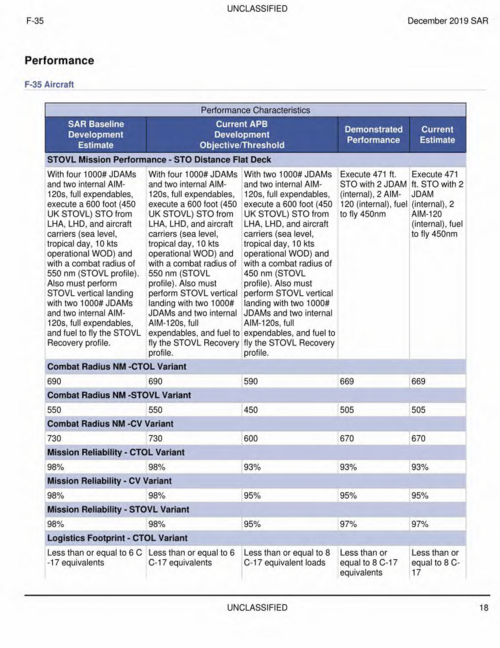
- Joined
- 29 November 2010
- Messages
- 1,775
- Reaction score
- 3,479
bringing the topic back to the Su-75 range (too much posting on the F-35 here).
if its as good as its claimed to be..
I am wondering if the 75 could potentially be the better base for a carrier aircraft than the 57, especially since there's been some news media claiming a carrier version is under consideration. In the Su-57 thread theres some concern about whether there is enough space for a tailhook due to the tandem bays (I think there is), but with the 75 there should definitely be enough space.
while it may not have the same potential range as the 57, it could be sufficient enough?
as a smaller aircraft, it could be a better fit for the current and perhaps future carrier space
if its as good as its claimed to be..
I am wondering if the 75 could potentially be the better base for a carrier aircraft than the 57, especially since there's been some news media claiming a carrier version is under consideration. In the Su-57 thread theres some concern about whether there is enough space for a tailhook due to the tandem bays (I think there is), but with the 75 there should definitely be enough space.
while it may not have the same potential range as the 57, it could be sufficient enough?
as a smaller aircraft, it could be a better fit for the current and perhaps future carrier space
LMFS
ACCESS: Top Secret
- Joined
- 19 March 2019
- Messages
- 534
- Reaction score
- 880
I think in a naval fighter the capabilities are even more important than in a land based ones, because the resource of numbers is much more restricted, therefore you should go for the best fighter available. There is a number of elements the Su-57 has that the LTS does not or in a much smaller amount (range, payload, speed) that are relevant if Russia wants to have the quality factor in its favour, given it is clear the size of the carrier air wings will be way smaller than China or US in the foreseeable future. Exchange ratios are highly sensitive (non linearly) to capability differences between platforms and weapons systems.
I would think the smaller aircraft would make for a more potent airwing, albeit probably at shorter ranges. Easier deck handling and more airframes. But I think a navalized fighter is a relatively minor consideration for Russia.
LMFS
ACCESS: Top Secret
- Joined
- 19 March 2019
- Messages
- 534
- Reaction score
- 880
Let us put that in context:I would think the smaller aircraft would make for a more potent airwing, albeit probably at shorter ranges. Easier deck handling and more airframes. But I think a navalized fighter is a relatively minor consideration for Russia.
> In A2G/A2S, the Su-57 can carry twice as many pieces of heavy ordnance at (quite likely) longer ranges and have substantially quicker turn-around times because of its supercruising ability
> In the A2A role, it has superior stored kills and far better kinematics and sensors, qualities which play a disproportionate role in skewing the exchange ratios in a confrontation
> With dimensions of ca. 17.5/12m vs 20/14 and particularly using the same wings, the Su-75 is not so much smaller in terms of footprint, compared to the Su-57. It would be very relevant to know the specific flight deck and hangar dimensions of the carrying vessel to know how many airframes of both could be actually carried, but two squadrons of Su-57, which could fit in a relatively small carrier, would already be a very serious force, because of the qualitative edge they would have on other naval fighters, provided the required supporting and battle management assets are also available for the VMF.
That being considered, I don't think the advantages provided by the Su-57 could be offset by say a 30% higher number of LTS embarked units even in quantitative metrics and qualitatively the Su-57 it would be substantially more capable.
Re. the relative low relevance of naval aviation for Russia, that is pretty much the case currently, but in the future that is expected to change progressively, as the VMF is built up and its blue water presence / power projection roles increase.
Last edited:
Ainen
I really should change my personal text
- Joined
- 25 August 2011
- Messages
- 1,284
- Reaction score
- 1,725
Depends on how you set your design priorities.I would think the smaller aircraft would make for a more potent airwing, albeit probably at shorter ranges. Easier deck handling and more airframes. But I think a navalized fighter is a relatively minor consideration for Russia.
S-56 by Sukhoi was a case that it's perfectly possible to produce a sound, long-range naval fighter design on a single AL-31F.
Plane strengthening would increase mass and kill range, just like it did with Su-33 vs baseline Su-27. SU-27P has 3900, Su-33 3000km range.bringing the topic back to the Su-75 range (too much posting on the F-35 here).
if its as good as its claimed to be..
I am wondering if the 75 could potentially be the better base for a carrier aircraft than the 57, especially since there's been some news media claiming a carrier version is under consideration. In the Su-57 thread theres some concern about whether there is enough space for a tailhook due to the tandem bays (I think there is), but with the 75 there should definitely be enough space.
while it may not have the same potential range as the 57, it could be sufficient enough?
as a smaller aircraft, it could be a better fit for the current and perhaps future carrier space
Acatomic
ACCESS: Secret
- Joined
- 18 October 2020
- Messages
- 245
- Reaction score
- 581
I think it was pretty clear in the news that VKS is not interested in Sukhoi LTS and that the only version they might get is the unmanned version. Pretty sure that it's the same situation with the Navy.
I wonder how much of a range increase a unmanned version would have (bigger internal fuel tanks, reduced drag...)?
I wonder how much of a range increase a unmanned version would have (bigger internal fuel tanks, reduced drag...)?
I think it was pretty clear in the news that VKS is not interested in Sukhoi LTS and that the only version they might get is the unmanned version. Pretty sure that it's the same situation with the Navy.
I wonder how much of a range increase a unmanned version would have (bigger internal fuel tanks, reduced drag...)?
Where did you see these news?
All I saw was Borisov and the VKS going "we might very well be interested" which I translated as "Sure, we can take it if the circumstances are right" -----> meaning they are not shouldering development costs, and will take it if the Gov/Rostec incentivizes it enough.
I think it was pretty clear in the news that VKS is not interested in Sukhoi LTS and that the only version they might get is the unmanned version. Pretty sure that it's the same situation with the Navy.
I wonder how much of a range increase a unmanned version would have (bigger internal fuel tanks, reduced drag...)?
Where did you see these news?
All I saw was Borisov and the VKS going "we might very well be interested" which I translated as "Sure, we can take it if the circumstances are right" -----> meaning they are not shouldering development costs, and will take it if the Gov/Rostec incentivizes it enough.
As for the tactical manned combat aircraft, judging by public statements, a higher priority for the Ministry of Defense has the development of the PAK DP interceptor and new STOVL fighter.
Eeeeeeeeegh...nd new STOVL fighter.
Eeeeeeeeegh...nd new STOVL fighter.
Eeeegh uuuugh aaaaarghhh some work was already part of the ГПВ-2027.

Борисов: по поручению Путина создается прототип самолета вертикального взлета
Такая машина может появиться через 7-10 лет, отметил вице-премьер РФ
- Joined
- 27 March 2006
- Messages
- 1,874
- Reaction score
- 1,621
Is there an English version of that?
Eeeegh uuuugh aaaaarghhh some work was already part of the ГПВ-2027.

Борисов: по поручению Путина создается прототип самолета вертикального взлета
Такая машина может появиться через 7-10 лет, отметил вице-премьер РФwww.google.com
For some reason, my phone is refusing to translate that from Russian into English...
Is there an English version of that?
Eeeegh uuuugh aaaaarghhh some work was already part of the ГПВ-2027.

Борисов: по поручению Путина создается прототип самолета вертикального взлета
Такая машина может появиться через 7-10 лет, отметил вице-премьер РФwww.google.com
For some reason, my phone is refusing to translate that from Russian into English...
Yes:

Russia developing vertical take-off plane on Putin’s instruction
Now work is underway to develop conceptual models and prototypes, according to Deputy Prime Minister Yuri Borisov
FighterJock
ACCESS: Above Top Secret
- Joined
- 29 October 2007
- Messages
- 5,609
- Reaction score
- 5,941
Is there an English version of that?
Eeeegh uuuugh aaaaarghhh some work was already part of the ГПВ-2027.

Борисов: по поручению Путина создается прототип самолета вертикального взлета
Такая машина может появиться через 7-10 лет, отметил вице-премьер РФwww.google.com
For some reason, my phone is refusing to translate that from Russian into English...
Yes:

Russia developing vertical take-off plane on Putin’s instruction
Now work is underway to develop conceptual models and prototypes, according to Deputy Prime Minister Yuri Borisovwww.google.com
So now it is official, Russia to begin to design a new vertical take of fighter.
Is there an English version of that?
Eeeegh uuuugh aaaaarghhh some work was already part of the ГПВ-2027.

Борисов: по поручению Путина создается прототип самолета вертикального взлета
Такая машина может появиться через 7-10 лет, отметил вице-премьер РФwww.google.com
For some reason, my phone is refusing to translate that from Russian into English...
Yes:

Russia developing vertical take-off plane on Putin’s instruction
Now work is underway to develop conceptual models and prototypes, according to Deputy Prime Minister Yuri Borisovwww.google.com
So now it is official, Russia to begin to design a new vertical take of fighter.
These articles are three years old. According to Borisov, conceptual work on the aircraft has been running since 2017. We will hardly see a prototype of the aircraft until 2025, but in the second half of the decade it probably will. This period coincides with the expected testing time of the 23900 project. Everything is, of course, questionable, however, the interest in the new aircraft is from both Putin and Borisov, who has meanwhile become Deputy Prime Minister.
- Joined
- 27 March 2006
- Messages
- 1,874
- Reaction score
- 1,621
Thanks Geo.
I remember that article. I had assumed there was updated info.
I remember that article. I had assumed there was updated info.
Sure-sure. And YET it saw much less real work aside from vague conceptualization outside of any proper R&D, unlike, and has MUCH less place in current or furure structure of russian armed forces, unlike.Eeeeeeeeegh...nd new STOVL fighter.
Eeeegh uuuugh aaaaarghhh some work was already part of the ГПВ-2027.

Борисов: по поручению Путина создается прототип самолета вертикального взлета
Такая машина может появиться через 7-10 лет, отметил вице-премьер РФwww.google.com
Sure-sure. And YET it saw much less real work aside from vague conceptualization outside of any proper R&D, unlike, and has MUCH less place in current or furure structure of russian armed forces, unlike.Eeeeeeeeegh...nd new STOVL fighter.
Eeeegh uuuugh aaaaarghhh some work was already part of the ГПВ-2027.

Борисов: по поручению Путина создается прототип самолета вертикального взлета
Такая машина может появиться через 7-10 лет, отметил вице-премьер РФwww.google.com
Eeeeeghh
In the name of the truth, top Russian officials should apologize to couch experts for spreading fake news.
No. This link contains the word "samolet" (aircraft), but not the word "istrebitel" (fighter).So now it is official, Russia to begin to design a new vertical take of fighter.
It is trite, but it may still be the same "spoiled phone" from the Russian media, so typical for them.
Moreover, there were reports that there are plans for a tiltrotor.
For me, this is generally a question of an unmanned tiltrotor from the "Kronstadt" group (well, or whatever it is called there now).
Similar threads
-
MAKS 2021 Airshow General News Topic
- Started by overscan (PaulMM)
- Replies: 35

